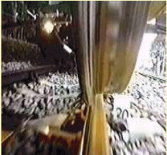|
To clarify and quantify the factors that cause derailment, running tests were carried out on the test line of RTRI (Fig. 1). A bench test was also implemented to measure the creep force between wheel and rail. In addition, the friction coefficient of rail surface was measured on commercial lines.
In the running tests, flange climb derailment at low speed was reproduced under the dry condition at sharp curved and twisted tracks. Measurements were also obtained on the behaviors of wheelset and wheel/rail contact force, which are the height of flange climbing, angle of attack, creep forces between wheel and rail, external forces and moments exerted on the wheelset. Flange climbing occurred at the point where the 5.0 m twist of track extended 20 mm or over. From the results of these running tests, it was found that flange climbing occurred when comparatively large values were observed with three indexes, the ratio of lateral to vertical force on a wheel at the inner rail side, derailment quotient at the outer rail side and the ratio of off-loading on the outer rail side wheel (Fig. 2)
In a creep force test, the characteristics of creep force between wheel and rail were investigated when the flange of wheel started to climb the rail by using roller-rigs and a wheelset with the conventional tread whose flange angle was 60 degrees. The maximum value of the ratio of lateral creep force to normal force on a wheel running at low speed under dry condition, which would come flange climbing, was about 0.5 at the inner rail side where the wheel tread contacted with roller. The values on the flange climbing wheel varied in a wide range and were slightly smaller than those of the inner side wheel at the angle of attack less than the equivalent value when a vehicle ran on curves whose radius were 160 m (Fig. 3).
This study was subsidized by the Ministry of Land, Infrastructure and Transport.
|










































